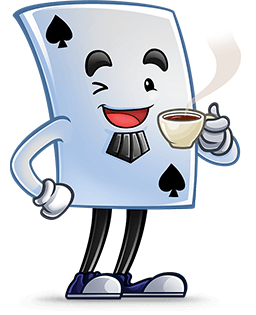Tri Peaks Objective
The goal of Tri Peaks, also known as Three Peaks, Triple Peaks, or Tri Towers, is to move all cards from the
tableau to the foundation pile by pairing cards that are one rank higher or lower than that top foundation card.
You cannot wrap ranks, so, because aces are low, you can’t place an ace on a king or a king on an ace.
With a win rate of 16%, Tri Peaks Solitaire is considered relatively difficult to
beat. Easy Tri Peaks, which allows you to wrap ranks, is a good
introduction to the game if standard Tri Peaks is too challenging.
Tri Peaks Setup
You can play Tri Peaks Solitaire with a standard deck of 52 playing cards or online for free on Solitaire Bliss!
There are three key areas in Tri Peaks:
- Tableau: The tableau consists of 28 face-up cards in the shape of three peaks, hence the game’s name.
The top row has 3 cards, the second row has 6, the third row 9 and the bottom row 10. All cards are
overlapped by two cards in the row directly under it, except for the bottom row where all cards are exposed
and can be used in gameplay.
- Stockpile: The stockpile consists of 23 facedown cards. You can flip a new card from the stockpile to
the foundation pile when there aren’t any available moves.
- Foundation pile: One card is dealt into the foundation pile to start the game. You pair tableau cards
with the top foundation pile card to clear the tableau.

How to Play Tri Peaks
You win Tri Peaks Solitaire by moving all the cards from the tableau into the foundation pile. Follow these rules to play.
- Move a card from the tableau to the foundation pile if it is one rank higher or lower than the top
card. For example, if the top card of the foundation pile is a jack of diamonds, you can move the
queen of spades onto it. The queen becomes the new top card used for pairing.
- Only exposed cards can be played. Exposed cards are not covered by other cards. At the start of the
game, the 10 cards in the bottom row are exposed. As you progress further in gameplay, cards from other rows
are uncovered.
- If you get stuck, draw from the stockpile. If there isn’t an exposed tableau card that is one rank
higher or lower than the top foundation pile card, draw from the stockpile until you can make a move.
- Ranks can’t be wrapped. You can’t place an ace on a king or a king on an ace. Aces are low so they
can only be paired with a two.
- Only run through the stockpile once. Use this sparingly because if you run through the stockpile and
haven’t cleared the tableau, you lose the game.
If you clear the tableau before running out of cards in the stockpile, you win the game.

Tri Peaks Strategy
Tri Peaks rules are simple, but it takes strategy to win the game.
- Evaluate the tableau and plan your moves. Since all the cards in the tableau are face-up, you can
plan ahead at the beginning of the game. Make sure to pay attention to where the queens and twos are since
they are the only cards that kings and aces can be placed on.
- Look for sequences. Try removing long sequences and remember that you can move up and down in rank.
For example, if you have an eight in the foundation pile, you can remove a seven, eight, nine, ten, nine
from the tableau.
- Prioritize moves that will expose cards. Exposing cards gives you more opportunities to remove them
from the tableau. If you have the choice of removing a card that doesn’t expose cards underneath it or
removing a card that exposes two cards, choose the latter.
- Remove cards from the tableau evenly. This helps you maintain balanced access to hidden cards,
preventing situations where one peak becomes stuck, limiting your moves and making it difficult to win.
- Use the stockpile sparingly. You can only run through the stockpile once, so only use it when
necessary.
Other Games You’ll Enjoy
If you like pairing card games, you can choose from many other fun Solitaire variations.
- Pyramid Solitaire: Pair cards from the tableau and waste
pile that add up the 13, with the goal of clearing the tableau.
- Golf Solitaire: Pair cards that are one rank higher or
lower than the top foundation pile card to clear the tableau. Ranks can’t be wrapped.
- Mahjong Solitaire: Pair tiles with the same symbols to
clear the board.




